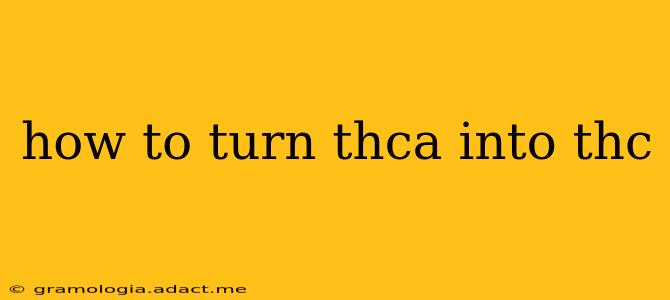THCA, or tetrahydrocannabinolic acid, is the non-psychoactive precursor to THC (delta-9-tetrahydrocannabinol), the primary psychoactive compound in cannabis. Many are curious about converting THCA into THC, primarily because THCA-rich products are often legally available where THC products are not. This guide explores the process, its implications, and important safety considerations.
It's crucial to understand: The legal status of THCA and THC varies significantly depending on your location. This information is for educational purposes only and should not be interpreted as an endorsement or instruction to perform any illegal activities. Always check and abide by local laws and regulations.
What is the Difference Between THCA and THC?
The key difference lies in a single chemical bond. THCA contains a carboxyl group (COOH) that THC lacks. This carboxyl group is what makes THCA non-psychoactive. The process of converting THCA to THC involves removing this carboxyl group through a process called decarboxylation.
How is THCA Decarboxylated into THC?
Decarboxylation of THCA is achieved through heat. The exact temperature and time required can vary slightly depending on the starting material and desired outcome, but generally speaking, the process involves heating THCA to a temperature around 220-240°F (104-115°C) for 30-45 minutes. This process breaks the carboxyl group, releasing carbon dioxide (CO2) and transforming THCA into THC.
Methods for Decarboxylating THCA:
- Oven Decarboxylation: This is a common method. Spread your THCA evenly on a baking sheet lined with parchment paper. Place it in a preheated oven at the appropriate temperature and time. Monitor closely to avoid burning.
- Slow Cooker Decarboxylation: A slow cooker provides a more even heat distribution, reducing the risk of burning. However, it takes longer than oven decarboxylation. Consult online resources for precise temperature and timing instructions for this method.
- Other Methods: There are other methods, such as using a sous vide or specialized decarboxylation devices, but these are less common for home use.
Important Safety Considerations:
- Ventilation: Decarboxylation produces carbon dioxide, so good ventilation is crucial. Work in a well-ventilated area or use an exhaust fan.
- Temperature Control: Overheating can degrade the THC and other beneficial cannabinoids, creating undesirable byproducts. Using a thermometer is recommended.
- Fire Safety: Always supervise the decarboxylation process. Avoid leaving the oven or slow cooker unattended.
What Happens After Decarboxylation?
Once decarboxylated, the THCA is now THC. You can then use the resulting material to make edibles, tinctures, or other infused products. Remember that the potency of the final product depends on the starting concentration of THCA and the efficiency of the decarboxylation process.
Can I Decarboxylate THCA at Home?
Yes, it is possible to decarboxylate THCA at home using readily available equipment like an oven or slow cooker. However, it requires careful attention to temperature and timing to achieve optimal results without degrading the THC.
Is it Legal to Decarboxylate THCA?
The legality of decarboxylating THCA depends entirely on your location and the regulations surrounding cannabis. Even in jurisdictions where THCA is legal, the resulting THC may not be. Always check your local laws before attempting this process.
What are the Risks Involved?
The primary risks involve overheating, leading to the degradation of cannabinoids and the creation of potentially harmful compounds. Always prioritize safety and carefully follow instructions. Improperly decarboxylated material may be less potent or even contain unwanted byproducts.
Conclusion
Turning THCA into THC involves a relatively straightforward decarboxylation process. However, precise temperature control, time management, and safety precautions are crucial for successful and safe conversion. Always remember to check your local laws and regulations before attempting any such process. This information is for educational purposes only and is not a guide for illegal activity.
